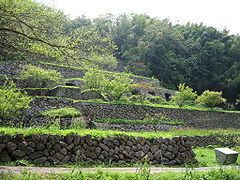Website www.city.ohda.lg.jp Population 38,837 (1 Jan 2012) Local time Monday 1:00 AM | Area 436.1 km² | |
 | ||
Time zone Japan Standard Time (UTC+9) City hall address 1111 Ōdaguchi, Ōda-machi, Ōda-shi, Shimane-ken694-0064 Weather 2°C, Wind S at 6 km/h, 95% Humidity Points of interest Iwami Ginzan Silver Mine, Hot Spring Tsu Hot Spring, Nima Sand Museum, Iwami Ginzan Silver Min, Sanbeazukiharamaibotsurin Park | ||
Japan trip yunotsu hot spring in world heritage site da shimane japan
Ōda (大田市, Ōda-shi) is a city located on the coast of the Sea of Japan in Shimane Prefecture, Japan.
Contents
- Japan trip yunotsu hot spring in world heritage site da shimane japan
- Map of Oda Shimane Prefecture Japan
- Japan travel yunotsu well known hot spring therapeutic effects world heritage site da shimane
- Geography
- Neighboring municipalities
- Economy
- Transportation
- History
- Iwami Ginzan Silver Mine
- Nima Sand Museum
- Sister cities
- References
Map of Oda, Shimane Prefecture, Japan
As of March 1, 2017, the city has an estimated population of 34,354 and a population density of 79 persons per km². The total area is 436.11 km². The city was founded on January 1, 1954. Ōda is home to the Iwami Ginzan Silver Mine, a World Heritage Site.
Japan travel yunotsu well known hot spring therapeutic effects world heritage site da shimane
Geography
Located in the central coastal portion of Shimane Prefecture, Ōda borders the Sea of Japan to the north and the Chūgoku Mountains to the south. Mount Sanbe (1,126 metres (3,694 ft)), part of Daisen-Oki National Park, is a double volcano of the Hakusan Volcanic Zone, and is situated to the southeast of the city.
Neighboring municipalities
Economy
Ōda remains a center of agricultural production. The city is a center for dairy farms. Additionally, the city is known for its roof tile industry, produced since early times as Iwami gawara, or kawara Japanese roof tiles of Iwami.
Transportation
Ōda is serviced by two transportation networks. The first is JR West Sanin Main Line, connecting Ōdashi Station to Tottori through Yonago and Matsue to the east, and connecting along the coast to Hamada and Masuda to the west.
The secondary transportation network is the Intercity bus.The Ōdashi Station is the terminal, and the line runs from Hiroshima Station and Hiroshima Bus Center.
History
The area of present-day Ōda located in Izumo Province. The area was a strategic meeting point of three ancient transportation routes: the San'in, Izumo, and the Bingo. As a result, numerous market towns were developed in the area.
On October 1, 2005, the towns of Nima and Yunotsu (both from Nima District) were merged into Ōda. Therefore, Nima District was dissolved as a result of this merger.
Iwami Ginzan Silver Mine
Ōda is home to the Iwami Ginzan Silver Mine, a World Heritage Site. Iwami Ginzan was the largest silver mine in Japanese history. Active for almost four hundred years, it operated from the discovery of silver in the area in 1526 until 1923. Iwami Ginzan was the most important source of silver to the Tokugawa Shogunate during the Edo period (1603 – 1868), and was directly controlled by the Tokugawa government. The mine is a popular tourist destination in Shimane, and can be reached by bus from Ōda Station on the JR West Sanin Main Line.
Nima Sand Museum
The Nima Sand Museum features a large hourglass mechanism that automatically rotates from December 31 to January 1. It is designated the largest hourglass in the world, but is not officially registered in Guinness World Records. This museum officially opened in March 1991.
Sand_p1 This museum features sand comprising six large and small pyramids made of crystal glass. The world’s largest hourglass Sunagoyomi measures the duration of a year and is displayed in the center of the building.
